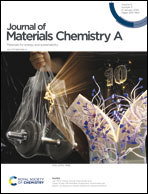Wood-based electrolyte with reversible phase transition for smart thermal-shutdown self-protection†
Abstract
The trade-off between the safety and electrochemical performance of electrolytes for electrochemical energy-storage devices is a key and urgent issue to be solved. Herein, a wood-based self-protection electrolyte (DW@SPE) was fabricated by delignified wood (DW), polyethylene oxide-block-polypropylene oxide-block-polyethylene oxide (PEO–PPO–PEO) and lithium chloride (LiCl) via vacuum soaking. DW@SPE displayed excellent electrochemical performance with high ionic conductivity and specific capacitance of 1.09 S m−1 and 112.1 F g−1, respectively. Interestingly, owing to the reversible phase transition characteristic of SPE and the unique channel structure of DW, DW@SPE had an anisotropic electrochemical thermal response. As the temperature increased to the phase transition point, the ionic conductivity of DW@SPE fell sharply when parallel to the through-channel direction of DW, showing the capability of smart thermal-shutdown self-protection. Contrarily, the ionic conductivity increased gradually as the temperature rose when perpendicular to the through-channel direction of DW, thereby exhibiting accurate temperature-sensing and sensitive fire-warning performance (2.6 s). DW@SPE self-extinguished rapidly after fire removal, and its limiting oxygen index reached 61.5%, demonstrating outstanding flame retardancy. Our work provides new insights into the fabrication and application of high-efficiency and high-safety electrolytes with natural renewable material, which is beneficial to promote the sustainable development of energy-storage devices.



 Please wait while we load your content...
Please wait while we load your content...